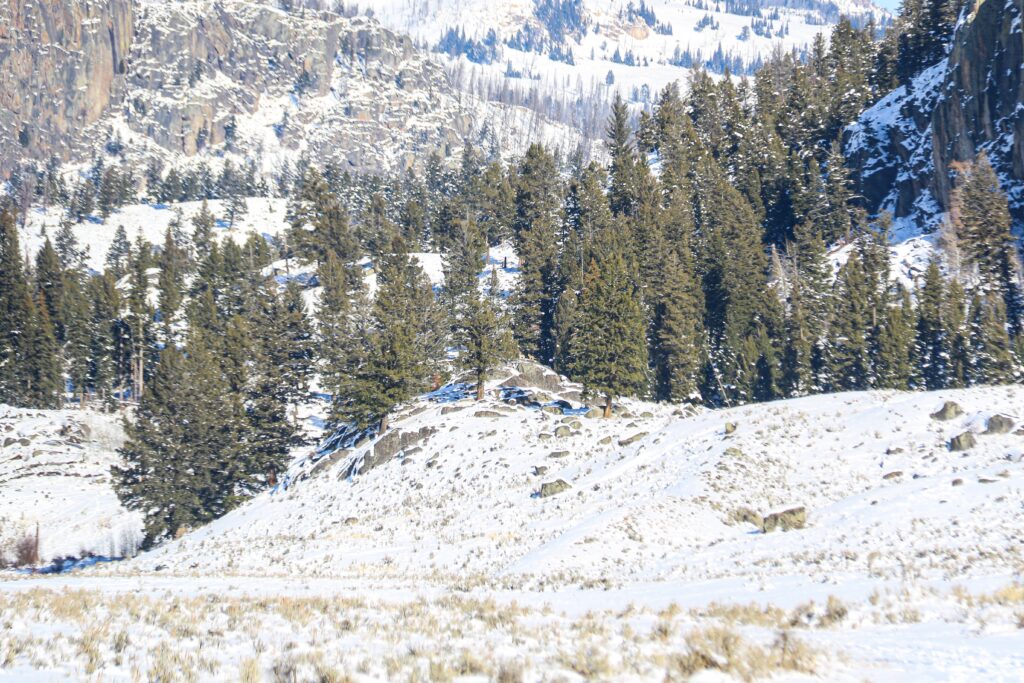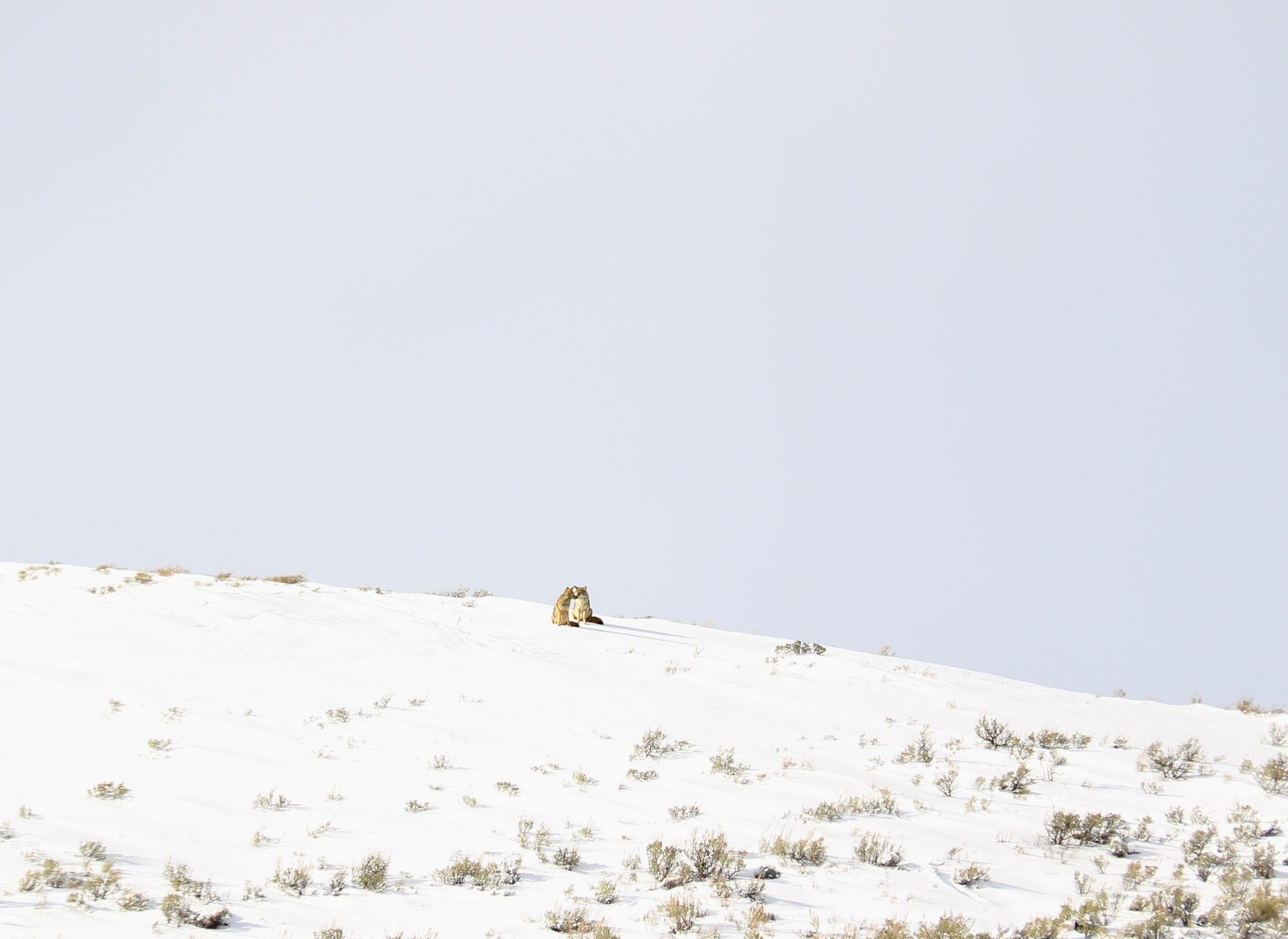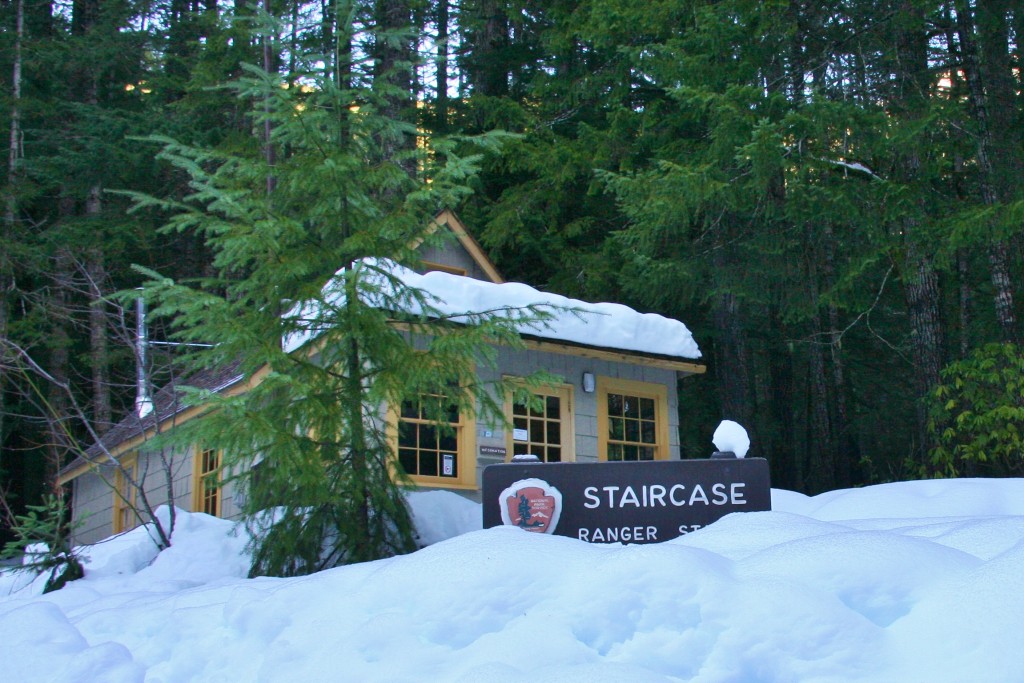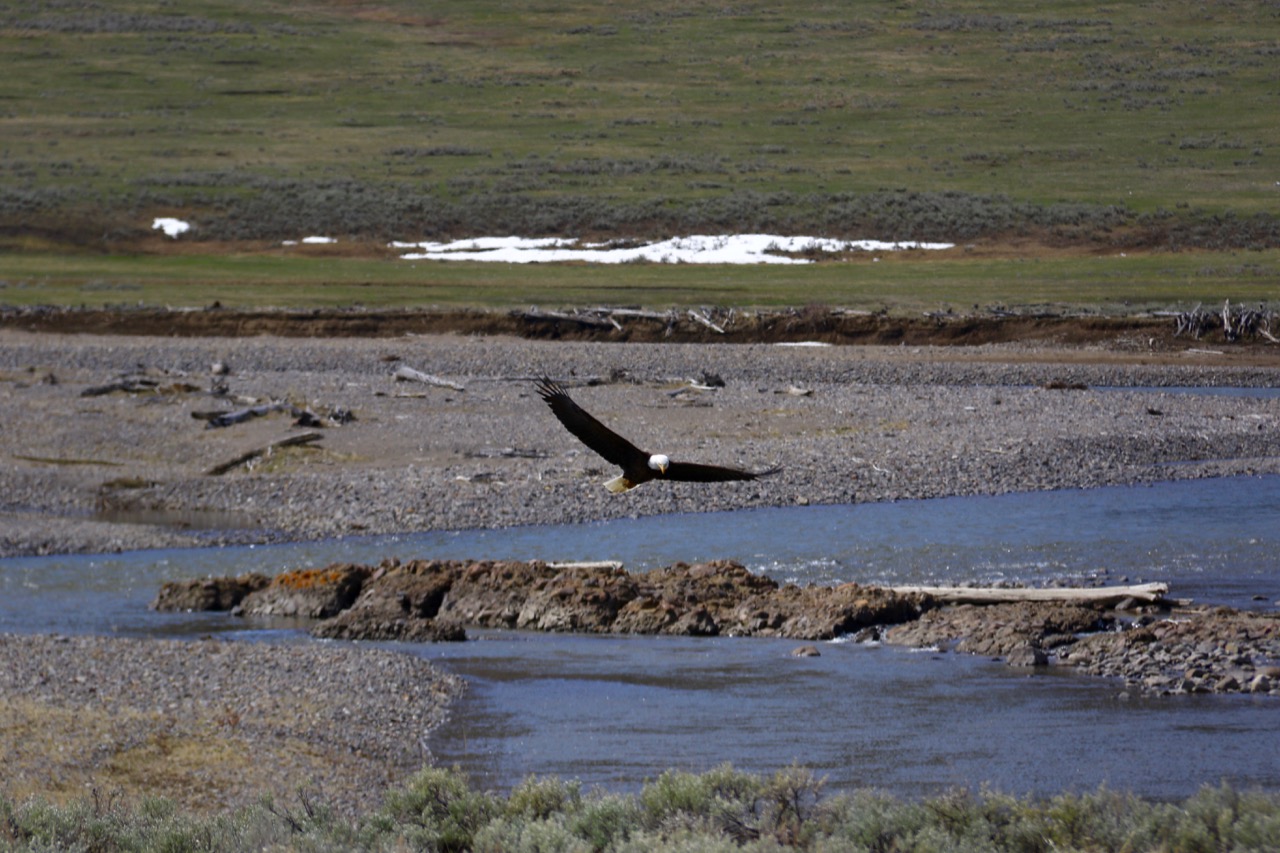Yellowstone National Park is a haven of awe-inspiring landscapes and diverse wildlife year-round, with the winter months being no different. Moose emerge in lower elevation settings and are easier to see, otters swim in the rivers and creeks near pullouts, and wolves feast on elk and bison they have successfully hunted. While this alone is worth a winter visit to the park, this time of the year is also one of my favorite times- it is the mating season for coyotes. Coyote mating season, adorned with intricate behaviors, including incredible sightings and a cacophony of noise in the mornings and evenings, contributes profoundly to the tapestry of life within the park’s ecosystem.
The coyote, scientifically known as Canis Latrans, is a highly adaptable and intelligent species found throughout North America. Coyotes find a suitable habitat in Yellowstone’s diverse terrain. The park, already a treasure trove of natural wonders, transforms into a sanctuary for observing the fascinating rituals of these creatures during the mating season, typically unfolding between the serene months of late January and March.
As the coyote’s calls echo through the crisp Yellowstone air, male coyotes become the conductors of the wilderness, emitting yips, howls, and barks that resonate across the landscape. These calls serve as a communication tool, establishing territorial boundaries, signaling reproductive readiness, and serenading potential mates.
Female coyotes exhibit monestrous behavior, meaning they go through estrus only once a year. The coyote estrous cycle spans approximately 10 days, and any attempts by a male to breed with an unready female are met with rejection and threats until the right time arrives. Growling, barking, yipping, and even whimpering, the female communicates her disinterest, making it abundantly clear to her suitor to leave her alone. During mating season male coyotes produce sperm exclusively, aligning with the limited window of female receptivity.
The courtship rituals of coyotes are a dance of connection, where playful and affectionate behaviors weave a tale of love. Males, the ardent suitors, bring offerings of nourishment to their intended partners, solidifying the bond between them. This courtship period acts as a discerning stage, allowing coyotes to assess each other’s suitability, ensuring only the most robust individuals contribute to the next generation.
It is important to note that while coyotes are generally monogamous, some males may experience frustration if a female isn’t quite ready for mating. In response, these males may go on the prowl, seeking a receptive mate elsewhere. However, the alpha male will eventually return to his original mate once she reaches optimal readiness, maintaining the monogamous dynamics within the coyote pack. Once both parties are ready, the coyote pairs engage in the physical dance of mating. This act seals their bond and heralds the beginning of a partnership that transcends the bounds of the mating season. Together, they embark on the noble quest of nurturing their offspring.
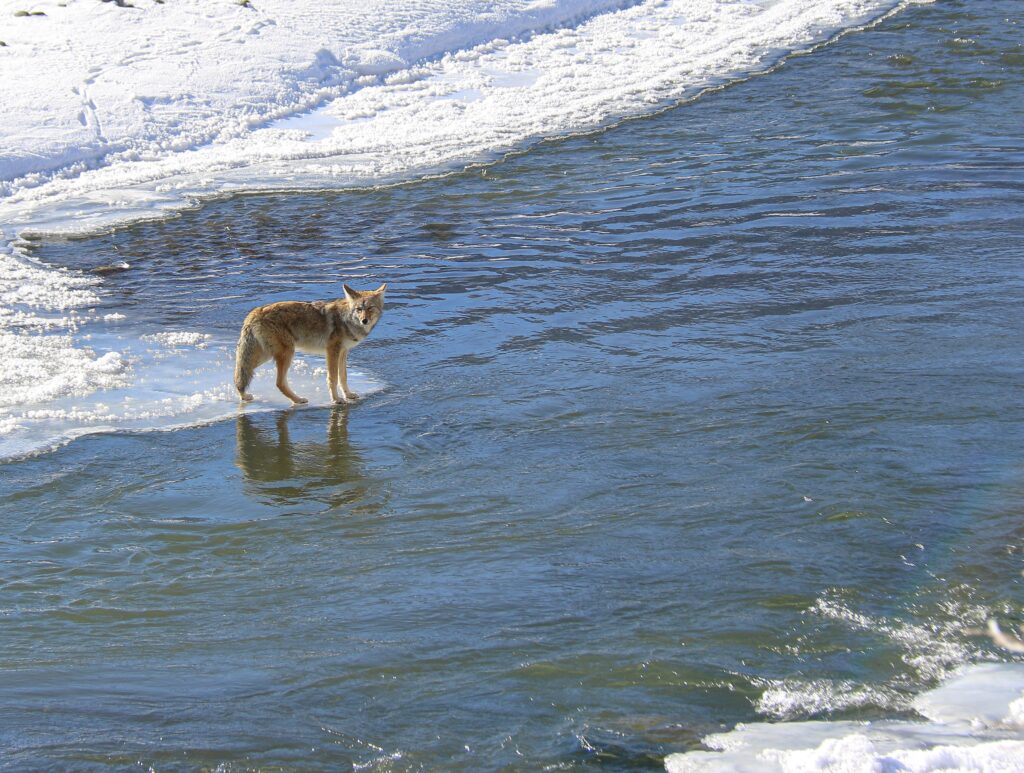
Where Can You See Coyotes in Yellowstone During Mating Season?
Coyotes can and are found in every corner of the park. However, during their mating season, only one section of road is open for personal vehicles in the park– the road between Gardiner, Montana, and Silver Gate/Cooke City. In my wildlife-watching guidebook for Yellowstone National Park, I have gone through every mile of the park and let you know what you might see where. Please pick up a copy if you enjoy my work.
If not, the simple answer to the title question of this section is as follows: Blacktail Ponds, Hellroaring, Tower-Roosevelt, Little America, Lamar Valley, Soda Butte Creek, and Pebble Creek/Round Prarie.
As always, do not approach wildlife, stay at appropriate distances from all animals, and never stop directly on the road- use the closest pullout.
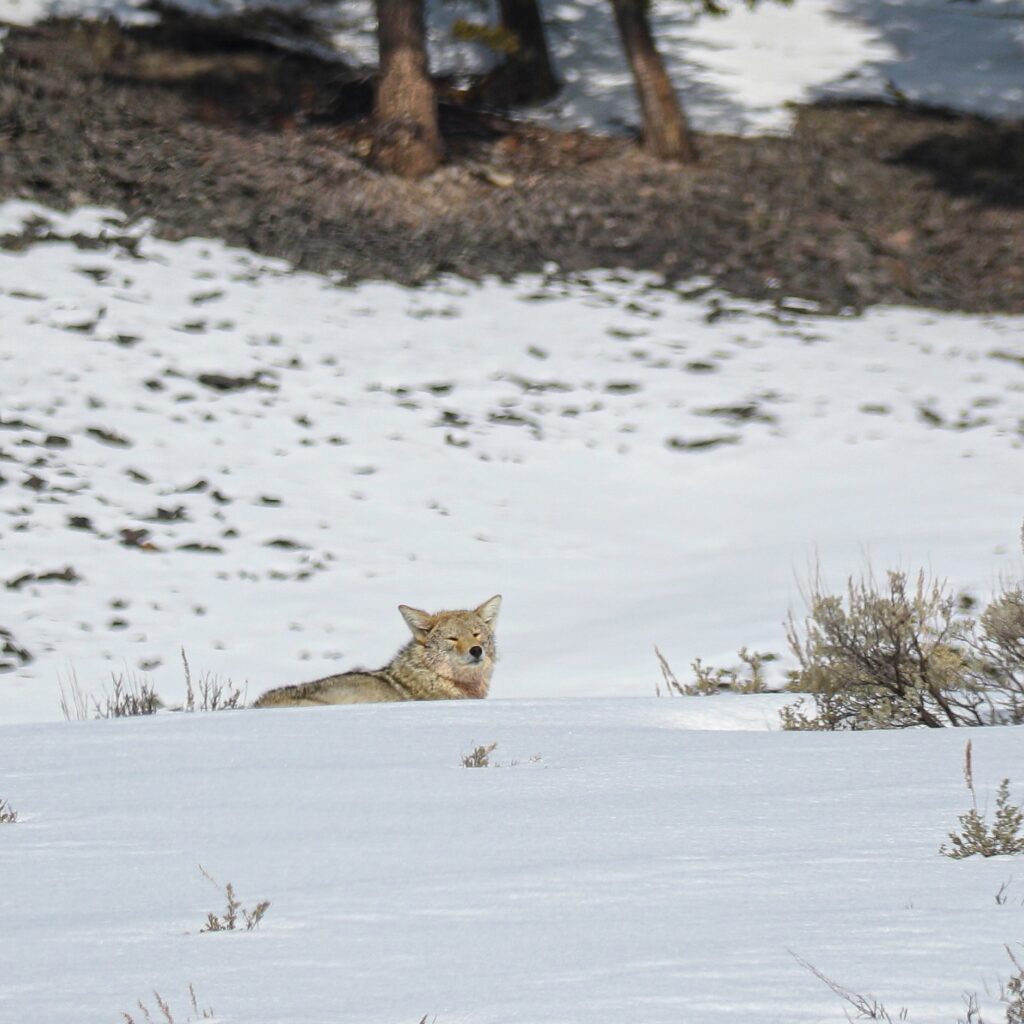
Once Mating Season is Over, What Happens?
A gestation period of roughly 60 days ensues, during which females seek out secluded dens to birth their precious pups. The timing of the mating season ensures the arrival of these new lives in the bountiful embrace of spring, enhancing the likelihood of their survival.
Coyote families emerge as vital players in the grand symphony of Yellowstone’s ecosystem, contributing harmoniously to the intricate balance of predator and prey relationships. The blind and vulnerable pups rely on the collective care and protection of their parents, both the gallant male and nurturing female, imparting essential survival skills. During this time, if food is scarce, you’ll see coyotes taking chances to bring food back to the den, occasionally testing their luck around wolves and even grizzlies.
For observers during the coyote mating season, Yellowstone becomes a stage for the interconnected ballet of life. The delicate web of relationships within the park’s ecosystem is illuminated, showcasing the vital role each species plays. Coyotes, as majestic predators and champions of biodiversity, embody the choreography of nature within this protected wilderness.
While the mating season brings vibrancy to Yellowstone, observers must maintain a respectful distance from these creatures. This ensures the well-being of both humans and coyotes, allowing the wild denizens to engage in their rituals undisturbed.
If you are fortunate enough to visit Yellowstone during the coyote mating season, enjoy it. Spotting these mating pairs together elevates the allure of the park’s natural wonders. From the calls of ardent males to the tender courtship gestures, each nuance of this season contributes to the perpetual magic of life within this iconic national treasure. As visitors appreciate the intrigue of Yellowstone, the coyotes fulfill their role in the tapestry of nature, showcasing the park’s essence as a sanctuary for wildlife and a living canvas for the dance of ecological processes.
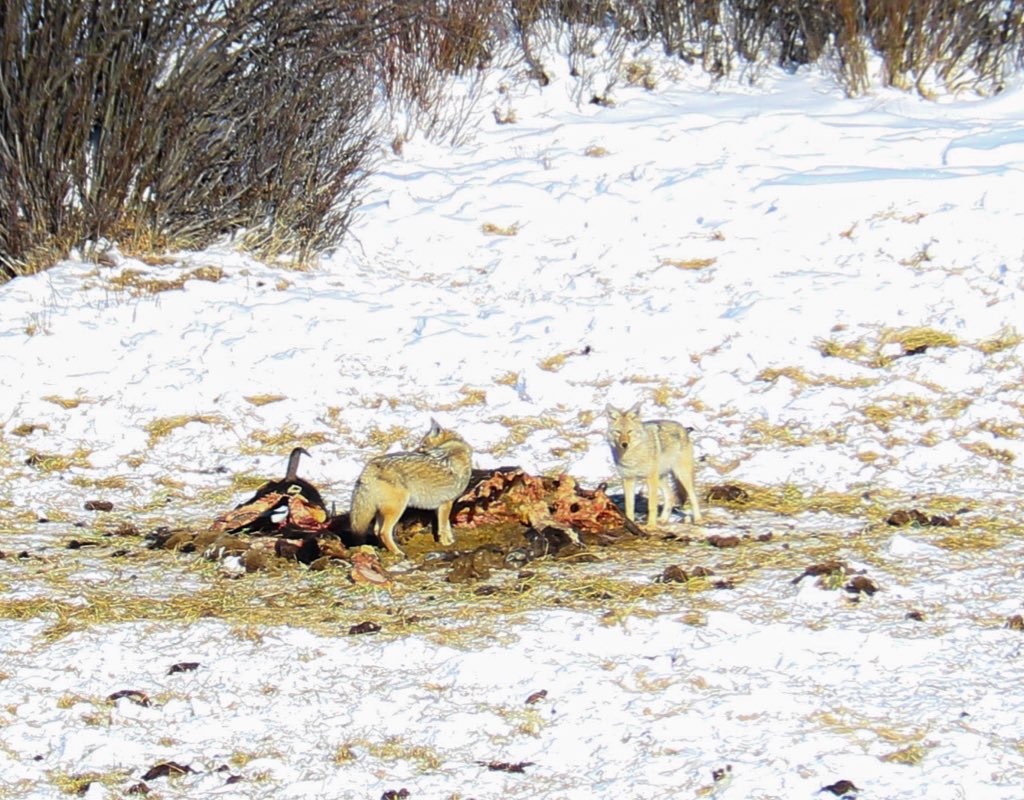
A Few Quick Facts About Yellowstone’s Coyotes
Weight and Size: Yellowstone coyotes typically weigh between 25-35 pounds. Standing at a height of 16-20 inches, these creatures embody a captivating blend of strength and agility.
Life Span: While their average life span is 6 years, coyotes in Yellowstone can live up to an impressive 13 years, contributing to the park’s unique wildlife longevity.
Roaming Habits: Yellowstone coyotes cover expansive territories, ranging between 3-15 miles in their daily roamings, showcasing their adaptability and nomadic nature.
Breeding and Birth: Coyote pups, a delightful addition to the park’s ecosystem, are born in April and make their first appearances in May, providing visitors with a charming spectacle of new life. Keep in mind that seeing coyote pups is extremely rare.
Dietary Preferences: Yellowstone coyotes have a diverse diet, primarily consisting of voles, mice, rabbits, and other small animals. Interestingly, they also display scavenging behavior, feeding on carcasses of dead bison and elk in the absence of wolves.
Impact of Wolf Reintroduction: The reintroduction of wolves to Yellowstone had a notable impact on the coyote population in the northern range, causing a 50% decrease. This ecological shift underscores the interconnected relationships within the park’s ecosystem.
Healthy Population and Visual Confusion: Yellowstone coyotes have rebounded, now boasting a healthy population. This resurgence of strong and healthy coyotes has led to visitors often mistaking them for wolves due to their robust size.
How Can You Tell the Difference Between a Coyote and Wolf: There are many tips and tricks to easily be able to identify whether you are looking at a coyote or wolf. I have included many pages on this topic in my wildlife-watching guidebook, which I would love if you got a copy. However, I am also sharing a link to Yellowstone National Park’s video titled “Inside Yellowstone: Coyote or Wolf?”
